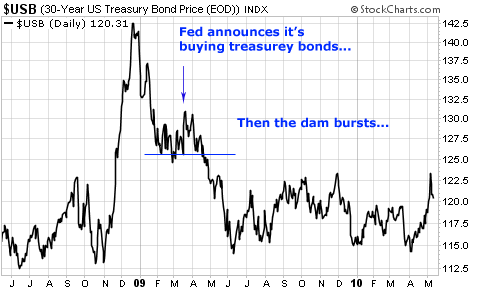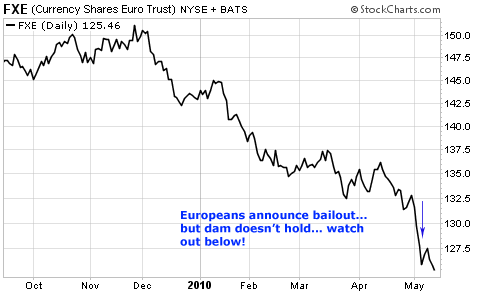| Home | About Us | Resources | Archive | Free Reports | Market Window |
You're Not Too Late: Three Euro Trades You Can Make This WeekBy
Saturday, May 15, 2010
In March 2009, the Federal Reserve announced it would spend $300 billion buying Treasury bonds...
The Federal Reserve has immense financial power. You'd expect this announcement to cause prices to rise in the Treasury bond market. And they did. The day they made the announcement, Treasury bond prices had their biggest one-day gain in history... and continued rising for a few days after.
Then, a funny thing happened. Treasury bonds started falling again... and a few weeks later, they were hitting new lows.
 Imagine trying to dam the Mississippi River. You use the world's strongest concrete, the most expensive machines, and the smartest engineers. For a while, your dam holds the river back. A reservoir forms. But then the dam starts crumbling. What do you think happens to the reservoir?
It gushes into the valley, of course.
When I saw the Federal Reserve's dam wasn't strong enough to hold back the Treasury bond price, I knew a flood was coming. Treasury bond prices were going to fall much farther. And as you can see in the chart above, that's exactly what happened.
Right now, the same situation is playing out with the euro.
The euro has been falling for almost six months over fears of a debt default by some of the bankrupt European governments. Last week, European bureaucrats announced a trillion-dollar bailout package, intended to protect these governments from default.
The euro soared on this news in one of the largest one-day rallies in many months. But guess what? The rally lasted about an hour. Last week, the euro broke to new lows again...
In other words, the European dam has failed. The forces pushing the euro down are too strong and there's a flood coming. Even though the euro has already fallen a long way... my broken dam theory makes me almost certain the euro's exchange rate will fall from here.
 There are several ways you can make this trade. Buying European manufacturing or commodity companies would be one way. These companies pay their costs in euros but earn their profits in dollars. When the euro falls, their costs fall. But this is too indirect for me...
Buying the double-short euro fund is a second way you could play this. The symbol is EUO. This is the trade I recommended to subscribers of my trading service, Penny Trends. (We timed it perfectly and my readers are showing a 25% gain.) Let's say my broken-dam theory is right and the euro falls to $1.20 this summer. That's a 5% move in the euro. The double-short euro fund will rise 10% in that scenario.
Buying a put option on the euro fund is your third choice, although I'd only recommend it for experienced option traders. The euro fund's symbol is FXE. It's a large fund and there's plenty of liquidity in the option market.
If none of the above ideas suit you, don't worry. With all the government intervention I see in our future, you'll have plenty more "broken dam" opportunities to take advantage of over the next few years...
Good investing,
Tom
Further Reading:
In currencies, once a trend gets going, it's hard to derail it. Last year, it was the dollar crashing. This year, it's the euro. One currency has seen its value climb for 10 years. And it looks like it could be many more years before this "steamroller" trend reverses. Read more here: The Greatest Currency Trade of the Millennium.
Anti-euro and anti-dollar hysteria is pushing one asset into "mania phase." This is when traders discard reasonable valuations, declare "this time is different," and push investments "10% or 20% in a month... 100% or 300% in a year... and 500% or more over the course of several years." Get in on the next mania here. Market NotesCHART OF THE WEEK: STOCKS AND GOLD ARE MOVING TOGETHER The thought running through many investors' minds goes something like this: "OK... all this crazed bailout spending by world governments has me worried about holding risky paper currencies. But should I flee government paper for gold... or for stocks?"
As our chart of the week shows, there hasn't been much difference lately. Below is a chart comparing the past year's gain in the price of gold (black line) versus the gain in stocks (S&P 500 index, blue line). As you can see, these two assets have moved almost in lockstep in the past 12 months... although gold has nudged higher in the past few weeks.
Remember... this is just a one-year snapshot. Gold has trounced stocks over the past eight years (gold has quadrupled, stocks are flat). But in a flight from paper currencies, owning both stocks and gold is the safe, diversified way to go.
|
Stat of the week
April 2006
Last time the euro currency was as low against the U.S. dollar as it is now. After briefly rallying in response to the $1 trillion bailout plan, the currency plunged.
In The Daily Crux
Recent Articles
|

